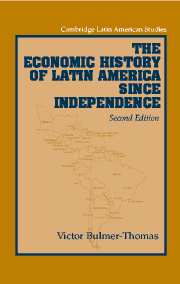Book contents
- Frontmatter
- Contents
- List of tables, figures, and maps
- Preface to the second edition
- Preface
- List of abbreviations
- 1 Latin American economic development: an overview
- 2 The struggle for national identity from independence to midcentury
- 3 The export sector and the world economy, circa 1850–1914
- 4 Export-led growth: the supply side
- 5 Export-led growth and the nonexport economy
- 6 The First World War and its aftermath
- 7 Policy, performance, and structural change in the 1930s
- 8 War and the new international economic order
- 9 Inward-looking development in the postwar period
- 10 New trade strategies and debt-led growth
- 11 Debt, adjustment, and the shift to a new paradigm
- 12 Conclusions
- Appendix 1 Data sources for population and exports before 1914
- Appendix 2 The ratio of exports to gross domestic product, the purchasing power of exports, and the volume of exports, circa 1850 to circa 1912
- Appendix 3 Gross domestic product per head, 1913, 1928, 1980, and 2000
- Bibliography
- Index
- CAMBRIDGE LATIN AMERICAN STUDIES
6 - The First World War and its aftermath
Published online by Cambridge University Press: 05 June 2012
- Frontmatter
- Contents
- List of tables, figures, and maps
- Preface to the second edition
- Preface
- List of abbreviations
- 1 Latin American economic development: an overview
- 2 The struggle for national identity from independence to midcentury
- 3 The export sector and the world economy, circa 1850–1914
- 4 Export-led growth: the supply side
- 5 Export-led growth and the nonexport economy
- 6 The First World War and its aftermath
- 7 Policy, performance, and structural change in the 1930s
- 8 War and the new international economic order
- 9 Inward-looking development in the postwar period
- 10 New trade strategies and debt-led growth
- 11 Debt, adjustment, and the shift to a new paradigm
- 12 Conclusions
- Appendix 1 Data sources for population and exports before 1914
- Appendix 2 The ratio of exports to gross domestic product, the purchasing power of exports, and the volume of exports, circa 1850 to circa 1912
- Appendix 3 Gross domestic product per head, 1913, 1928, 1980, and 2000
- Bibliography
- Index
- CAMBRIDGE LATIN AMERICAN STUDIES
Summary
When war broke out in Europe on 2 August 1914, it was not just the international balance of power that was shattered; the global trade and payments system, which had slowly evolved since the end of the Napoleonic wars, was also thrown into disarray. With the signing of the armistice in 1919, a brave face was put on attempts to reconstruct the prewar system. The old international economic order had perished, however, and the new one was dangerously unstable. This instability was scarcely perceived at the time, leaving peripheral regions, such as Latin America, extremely vulnerable to the collapse of international trade and capital flows at the end of the 1920s.
The main feature of the old order had been the existence of relatively unrestricted international trade – a reflection of the interests of the dominant economic power (Great Britain) in the nineteenth century; the limited restrictions in force generally took the form of tariffs, which had the advantage for all concerned of being transparent. Both capital and labor were free to move across international boundaries, and passports were the exception rather than the rule. The gold standard, adopted first by Great Britain, had spread to all the main industrial countries by the end of the century and provided a well-established mechanism for balance-of-payments adjustment. Internal equilibrium (full employment and zero inflation) was regarded as less important than external equilibrium, so the burden of adjustment to adverse shocks was usually achieved through price deflation and underemployment.
- Type
- Chapter
- Information
- The Economic History of Latin America since Independence , pp. 152 - 188Publisher: Cambridge University PressPrint publication year: 2003

